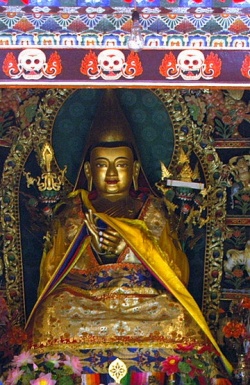Two truths doctrine
The Buddhist doctrine of the two truths (Tibetan: bden-pa gnyis) differentiates between two levels of truth (Sanskrit: satya) in Buddhist discourse: relative or commonsensical truth, and absolute or ultimate truth.
The doctrine was first expressed in complete form by Nāgārjuna.
Etymology and definition
The two truths doctrine states that there is:
- Relative truth or common-sense truth (Sanskrit samvṛtisatya, Pāli sammuti sacca, Tibetan kun-rdzob bden-pa), which describes our daily experience of a concrete world, and
- Ultimate truth (Sanskrit, paramārthasatya, Pāli paramattha sacca, Tibetan: don-dam bden-pa), which describes the ultimate reality as sunyata, empty of concrete and inherent characteristics.
The Sanskrit term for relative, "samvṛti", also implies false, hidden, concealed, or obstructed, as well as other nuanced concepts.
The conventional truth may be interpreted as "obscurative truth" or "that which obscures the true nature" as a result. It is constituted by the appearances of mistaken awareness. Conventional truth would be the appearance that includes a duality of apprehender and apprehended, and objects perceived within that. Ultimate truths, are phenomena free from the duality of apprehender and apprehended.
Origin and development
While the concept of the two truths is associated with the Madhyamaka school, its history goes back to the oldest Buddhism.
In the Pali canon, the distinction is not made between a lower truth and a higher truth, but rather between two kinds of expressions of the same truth, which must be interpreted differently. Thus a phrase or passage, or a whole sutta, might be classed as neyyattha or samuti or vohāra, but it is not regarded at this stage as expressing or conveying a different level of truth.
Nītattha (Pāli; Sanskrit: nītārtha), "of plain or clear meaning" and neyyattha (Pāli; Sanskrit: neyartha), "[a word or sentence] having a sense that can only be guessed". These terms were used to identify texts or statements that either did or did not require additional interpretation. A nītattha text required no explanation, while a neyyattha one might mislead some people unless properly explained:
Saṃmuti or samuti (Pāli; Sanskrit: saṃvṛti, meaning "common consent, general opinion, convention", and paramattha (Pāli; Sanskrit: paramārtha), meaning "ultimate", are used to distinguish conventional or common-sense language, as used in metaphors or for the sake of convenience, from language used to express higher truths directly. The term vohāra (Pāli; Sanskrit: vyavahāra, "common practice, convention, custom" is also used in more or less the same sense as samuti.
The Theravādin commentators expanded on these categories and began applying them not only to expressions but to the truth then expressed:
- The Awakened One, the best of teachers, spoke of two truths, conventional and higher; no third is ascertained; a conventional statement is true because of convention and a higher statement is true as disclosing the true characteristics of events.
The Prajnāptivāda school took up the distinction between the conventional and ultimate (paramārtha/saṃvṛti), and extended the concept to metaphysical-phenomenological constituents (dharmas), distinguishing those that are real (tattva) from those that are purely conceptual, i.e., ultimately nonexistent (prajnāpti).
The distinction between the two truths (satyadvayavibhāga) was fully expressed by the Madhyamaka-school. In Nāgārjuna's Mūlamadhyamakakārikā it is used to defend the identification of dependent origination (pratītyasamutpāda) with emptiness (śūnyatā):
- The Buddha's teaching of the Dharma is based on two truths: a truth of worldly convention and an ultimate truth. Those who do not understand the distinction drawn between these two truths do not understand the Buddha's profound truth. Without a foundation in the conventional truth the significance of the ultimate truth cannot be taught. Without understanding the significance of the ultimate, liberation is not achieved.
- The teaching by the Buddhas of the dharma has recourse to two truths:
- The world-ensconced truth and the truth which is the highest sense.
- Those who do not know the distribution (vibhagam) of the two kinds of truth
- Do not know the profound "point" (tattva) in the teaching of the Buddha.
- The highest sense of the truth is not taught apart from practical behavior,
- And without having understood the highest sense one cannot understand nirvana.
Nāgārjuna based his statement of the two truths on the Kaccāyanagotta Sutta. In the Kaccāyanagotta Sutta, the Buddha, speaking to the monk Kaccayana Gotta on the topic of right view, describes the middle Way between nihilsm and eternalism:
- By and large, Kaccayana, this world is supported by a polarity, that of existence and non-existence. But when one sees the origination of the world as it actually is with right discernment, "non-existence" with reference to the world does not occur to one. When one sees the cessation of the world as it actually is with right discernment, "existence" with reference to the world does not occur to one.
Understanding in Buddhist tradition
The Yogācāra-school distinguishes the three natures and the Trikaya.
The Lankavatara Sutra took an idealistic turn in apprehending reality. D.T.Suzuki writes the following:
The Lanka is quite explicit in assuming two forms of knowledge: the one for grasping the absolute or entering into the realm of Mind-only, and the other for understanding existence in its dual aspect in which logic prevails and the Vijnanas are active. The latter is designated Discrimination (vikalpa) in the Lanka and the former transcendental wisdom or knowledge (prajna). To distinguish these two forms of knowledge is most essential in Buddhist philosophy.
Tibetan Buddhism
The Nyingma tradition is the oldest of the four major schools of Tibetan Buddhism. It is founded on the first translations of Buddhist scriptures from Sanskrit into Tibetan, in the eighth century. Ju Mipham (1846–1912) in his commentary to the Madhyamālaṃkāra of Śāntarakṣita (725–788) says:
If one trains for a long time in the union of the two truths, the stage of acceptance (on the path of joining), which is attuned to primordial wisdom, will arise. By thus acquiring a certain conviction in that which surpasses intellectual knowledge, and by training in it, one will eventually actualize it. This is precisely how the Buddhas and the Bodhisattvas have said that liberation is to be gained.[a]
The following sentence from Mipham's exegesis of Śāntarakṣita's Madhyamālaṃkāra highlights the relationship between the absence of the four extremes (mtha'-bzhi) and the nondual or indivisible two truths (bden-pa dbyer-med):
The learned and accomplished [[[masters]]] of the Early Translations considered this simplicity beyond the four extremes, this abiding way in which the two truths are indivisible, as their own immaculate way.[b]
Dzogchen holds that the two truths are ultimately resolved into non-duality as a lived experience and are non-different.
Correspondence with Greek scepticism
McEvilley (2002) notes a correspondence between Greek Pyrrhonism and Madhyamika doctrines:
Sextus says that there are two criteria: 1.[T]hat by which we judge reality and unreality, and
According to the first criterion, nothing is either true or false[.] [I]nductive statements based on direct observation of phenomena may be treated as either true or false for the purpose of making everyday practical decisions.
- The distinction, as Conze has noted, is equivalent to the Madhyamika distinction between "Absolute truth" (paramārthasatya), "the knowledge of the real as it is without any distortion," and "Truth so-called" (saṃvṛti satya), "truth as conventionally believed in common parlance.



